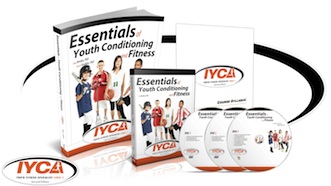Tips About Knee Injuries
 Knee injuries are rampant, and in the physical therapy world they tend to keep us employed.
Knee injuries are rampant, and in the physical therapy world they tend to keep us employed.
There are so many types of knee injuries that, for coaches, it can be hard to know what is what.
Patellofemoral Syndrome? Patellofemoral Dysfunction? Lateral Tracking Patella? Did you know those are the same thing?
So to break down the barriers to understanding knee injuries, here are…
5 Knee Related Tips that Every Coach Should Know
Tip #1: Basic Anatomy Factoid
The knee is the largest, most unstable, joint in the body. Somehow our evolution created a very large, somewhat disarticulated joint with a bony hockey puck on top, and 4 ligaments stringing it all together.
The ankle can move in two planes of motion very well. The hip moves in three planes of motion, and then the part between the two moves in one and if it moves in three, you have now lost your ACL!
This body part is set up for failure so that’s why tip #1 will hopefully shed light on tips #2-5.
Tip #2: The Joint is Sensitive But for Good Reason
There are millions of receptors coursing through the knee that transmit a lot of information.
When cutting on a basketball court and a little rotation at the knee is registered, what happens? Simple, the hips and lower back rotate—and the athlete goes up onto the ball of the foot to allow fluid motion to prevent twisting. This creates strong and efficient movement patterns.
The orientation of the kneecap (patella) allows the quad to generate increased force by making a bigger lever arm with every jump, land or sprint. It’s a great shock absorber when used correctly.
So when aches and pains start showing up in the knee, the message to the head is “I can’t handle the pressure, please stop.” Just think of it as a barometer for the lower body.
Ankles and hips have this type of capacity but they are also so intricately involved in balance strategy that they are focused on other tasks.
Tip #3: Address the Problem Early
Rolled ankles occur frequently. Hip joint injuries are less common, such as a labral tear, and when they happen it will really slow down or stop an athlete.
As a clinician that teaches online courses for Patellofemoral Syndrome and ACL Rehabilitation, please heed my recommendation to not ignore knee pain because there are a lot of causes.
For young athletes the most common response is “it’s just growing pains”, right? Sure, that could be the answer but let ME, (the Physical Therapist), figure that out.
Before, I mentioned the idea of the knee as a shock absorber. If a knee cannot handle the load, pressure, force, etc. going through it and the athlete continues to push through, changes will start to occur.
Pro Tip: Correctly using the forces of physics can build great athletes but when mismanaged becomes a wrecking ball.
Problems are much easier to address in the first couple of weeks. Timing and positioning mechanics of the knee—when pushed too far—eventually fall apart. Excessive loading through the patellar tendon can cause painful bone formation that we know as Osgood Schlatter’s.
Constant pain behind or on the side of the knee cap can cause maltracking. This is due to a bad combo of tightness and weakness in the quad muscles, known as Patellofemoral Syndrome.
Repeated abuse of the knee joint will begin to shut down quad strength because of this awful pain/inflammation cycle. If there is any uncertainty to the cause of knee pain, get the athlete to the doctor and hopefully to a sports-minded clinician that is going to figure out the underlying cause.
Pro Tip: The longer knee pain persists, the longer it will take to correct the problem.
Tip #4: Pain Does Not Equal Damage
This applies to any injury, but I find it very relevant to the knee. The knee is a very painful structure, as I mentioned—lots of tiny cells that relay information with every step. It is pretty well known in the physical therapy world that the fat pad behind the kneecap, which provides cushioning, when pinched is “drop to the floor” painful.
An IT band that slaps awkwardly across the outside of the knee joint may also take an athlete’s breath away. While both incredibly painful, when addressed appropriately can be quickly resolved.
Bringing this back to the “get it checked out” message I have already conveyed—as a coach it is important to realize this because fear and doubt will settle into the athlete’s brain.
Pro Tip: Pain is a way for the body to say “Hey, I don’t like what is going on here, do something about it.” Lots of things affect pain so getting a clear understanding of the cause is critical, before some real damage starts.
Tip #5: It’s Too Important to Cover Up
If you do not know what the issue is affecting the knee, don’t cover up the problem. I am talking about all the braces, bands, clips, gels, and bottles of anti-inflammatories that young athletes get rigged up with.
If your doctor or therapist recommended something like this, absolutely listen and follow the sound advice.
If an athlete is limping around and you slap on a compression sleeve and wrap, and then it miraculously feels better, it doesn’t mean the issue doesn’t still exist. The typical response is “back to business as usual”. STOP, and direct that child towards the doctor.
As adults, we mask things to make it through the workday, manage pains at home so we can bend over and bathe the kids, or perhaps to participate in recreational softball tournaments.
Children are not adults.
Take Home Message
A lot of the article may be interpreted as “any knee problem, take an athlete to the doctor.”
If an athlete’s knee is sore after doing box jumps for the first time, is slow moving following a run into a wall, or is a bit irritated after increasing running mileage from 5 to 7 miles, there are cases where you know a potential cause or instigator.
For the athletes that have been limping around for weeks and getting worse, a professional medical evaluation is warranted. I am always going to error on the side of caution with this type of thing because at the least, an athlete will get their part checked out and learn ways to head off problems before they start.
Dr. Keith Cronin, DPT
Help Prevent Injuries by Preparing Athletes To Perform
Learn how to leverage the Long Term Athletic Development Model to ensure your athletes are prepared to perform. In expert Wil Fleming’s free 7-minute video and PDF checklist, he covers how to create a training system that prepares young athletes to move better, get stronger, and enhance their performance.
About the Author: Keith J. Cronin
 Keith J. Cronin is a physical therapist and owner of Sports and Healthcare Solutions, LLC. Keith currently supports US Operations for Dynamic Tape®, the “Original” Biomechanical Tape®, providing guidance for education, research, and distribution. He graduated with his Doctorate in Physical Therapy (DPT) from Belmont University in 2008 and later earned his Orthopedic Certification Specialist (OCS).
Keith J. Cronin is a physical therapist and owner of Sports and Healthcare Solutions, LLC. Keith currently supports US Operations for Dynamic Tape®, the “Original” Biomechanical Tape®, providing guidance for education, research, and distribution. He graduated with his Doctorate in Physical Therapy (DPT) from Belmont University in 2008 and later earned his Orthopedic Certification Specialist (OCS).
Prior to graduate school, Keith was a collegiate baseball player and top-level high school cross country runner. He also had the opportunity to work as a personal trainer (CSCS) prior to his career in physical therapy, providing a very balanced approached to educating fitness and rehabilitation. Keith has focused his career on the evaluation, treatment, injury prevention, and sports conditioning strategies for athletes, with particular attention to youth sports. He currently lives in the St. Louis, MO area with his wife and two daughters, Ella and Shelby.
Additional noteworthy items about Keith:
- Keith is currently a reviewer for the International Journal of Sports Physical Therapy (IJSPT) on a variety of topics including throwing athletes, concussions, and ACL rehabilitation.
- Keith has produced several online CEU courses for PTWebcuation.com on the topics of running injuries, ACL rehabilitation, Patellofemoral Syndrome, and injuries to the Foot and Ankle.
- In 2012, Keith participated in a concussion education program in Newcastle, OK that resulted in the documentary “The Smartest Team: Making High School Football Safer” which had several runs on PBS worldwide.
- Keith has also been published in a variety of media, publishing almost 100 articles through venues including MomsTEAM.com, Advanced Magazine, the 9s Magazine, the American Coaching Academy, and Suite101.
- Keith was also featured on Fox2News several times on topics of concussions and ACL injuries.
- In 2008, Keith was a winner of the Olin Business Cup at Washington University for his product innovation “Medibite” a jaw rehabilitation system designed to improve the outcomes for individuals suffering TMJ dysfunction.




